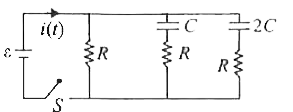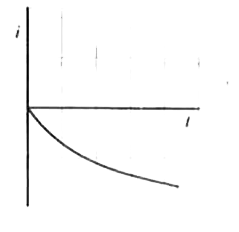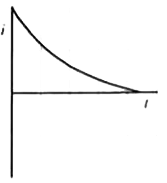The two capacitors, shown in the circuit, are initially uncharged and the cell is ideal.The switch S is closed at t = 0.

Which of the following functions represents the current i(t), through the cell as a function of time?Here i0,i1,i2 are constants.
A
i(t)=i0+i1e−tτ,τ=3C×R3
B
i(t)=i0+i1e−tτ+i2e−t2τ,τ=RC
C
i(t)=i1+i1e−tτ,τ=3C×R3
D
i(t)=i0+i1e−tτ,τ=3RC
Text Solution
The correct Answer is:B
The three branches of the circuits carry currents i=i0,i=i1etRC and i=i22e−t2RC respectively. The current through the cell, i() can be found by using Kirchhoff.s current law (or mode law).
|
Updated on:21/07/2023
Topper's Solved these Questions
Similar Questions
Knowledge Check
- Question 1 - Select One
In the circuit shown in the following figure, the switch is moved to position 1 at t = 0. Which of the following most closely represents the current I as a function of time?
 A
A B
B C
C D
D
- Question 2 - Select One
In the circuit shown, the capacitor is initially uncharged. The switch S is closed at t = 0. Time after which voltage across capacitor and resistor are equal is:
 ARCln12BRCln2CRCln32DRC
ARCln12BRCln2CRCln32DRC - Question 3 - Select One
In given circuit capacitorinitially uncharged.Now at t = 0 switch S is closed then current given by source at any time t is
 A2R(1−e−2tCR)Bε2R(1+e−2tCR)Cε2R(1−e−2tCR)D2εR(1−e−2tCR)
A2R(1−e−2tCR)Bε2R(1+e−2tCR)Cε2R(1−e−2tCR)D2εR(1−e−2tCR)
In the circuit shown in the figure The steady state currents i1andi2 in the coils after the switch S is closed are
 View Solution
View SolutionIn the circuit diagram shown, intially there is no energy in the inductor and the capacitor. The switch is closed at t=0 . Find the current I as a function of time t .
 View Solution
View SolutionIn the circuit shown, switch S is closed at time t=0. Find the current through the inductor as a function of time t.
 View Solution
View SolutionIn the circuit shown, switch S is closed at time t=0. Find the current through the inductor as a function of time t.
 View Solution
View SolutionIn the circuit shown in the figure The steady state currents i1andi2 in the coils after the switch S is closed are
 View Solution
View Solution



